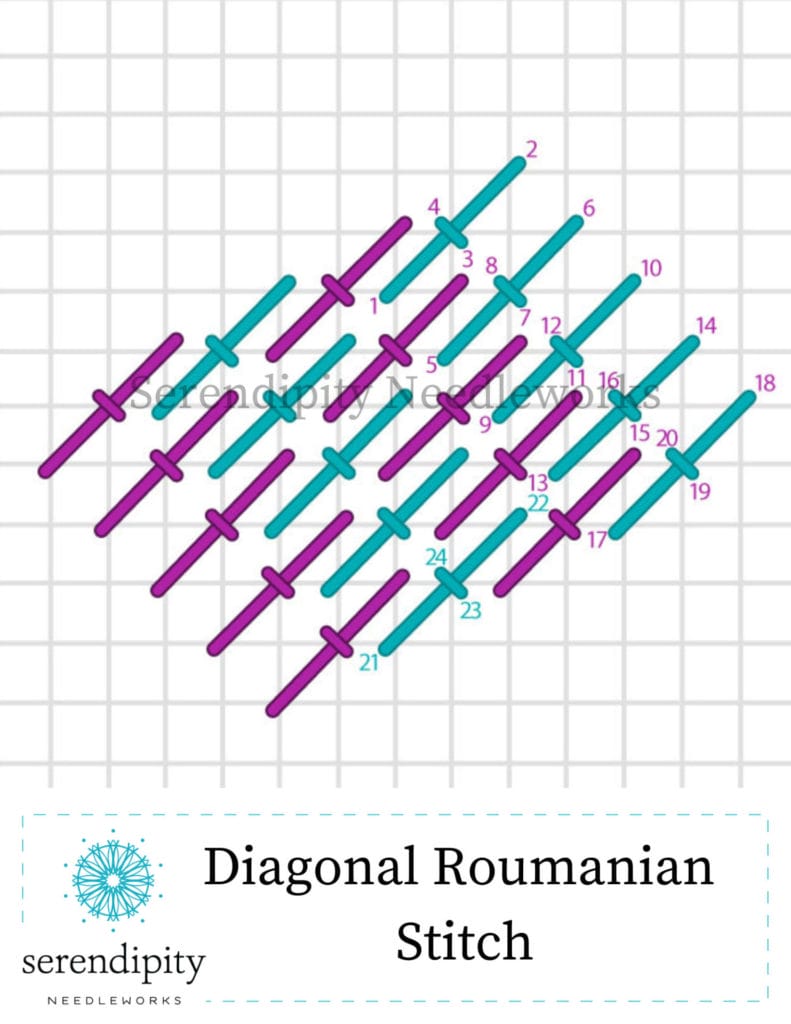Baskets of bright red apples line the shelves at the Farmer’s Market, the trees are starting to turn, and the days have taken on a golden hue. Autumn is at hand, so grab your favorite mug, fill it up, and let’s chat about this week’s featured stitch – the diagonal Roumanian stitch.
The diagonal Roumanian stitch is one of those stitches that you can use almost anywhere on your needlepoint canvases. It’s just that versatile. Since we only have a wee bit of time together, though, we’re going to focus on some ways that you can use it on your fall-themed designs.
The diagonal Roumanian stitch is a member of the crossed stitch family. One of my favorite things about this stitch is that you can use it very successfully for shading a design component – like the vibrant orange pumpkin on our “Squash Blossoms” canvas by Sandra Gilmore.

Since the pattern is worked in diagonal rows, you can easily make subtle color changes within a row or row by row.
Here’s the diagram for you…

Work the long diagonal stitch first, then complete the stitch unit with a reverse tent stitch across the center of the long stitch.
Let’s look at how you can use the diagonal Roumanian stitch for shading within a single row first.
We’ll use three lovely shades of orange Needlepoint Inc. Silk (862, 864, and 866) for our example. Begin with the lightest value, 862, and work the entire stitch in that color.
Then, work the next long stitch in the row in 862. Complete the stitch unit by working the reverse tent stitch in the next darker value, 864.
Moving on down the row, work the third stitch entirely in 864, too. Work the long stitch portion of the fourth stitch in 864, as well.
Finally, switch to the third value of orange in the palette, 866. Complete the fourth stitch by working the reverse tent stitch portion of the unit. Work the entire fifth stitch in 866, too.
When applying this technique to your project, follow the painted design on your canvas. Match the colors of the thread with the artist’s shading. (That means you may need to work multiple stitches in the same color before transitioning to the next value in your palette.)
The other method for shading with the diagonal Roumanian stitch is to change values from row to row.
In other words, work an entire diagonal row in a single value. Then, switch to the next darker value. Following the artist’s shading on your painted design. If you’re newer to shading, this is the easier of the two methods, for sure!
Now, let’s talk about some different threads that you might use for shading on your fall-themed canvases.
There are a lot of lovely stranded threads in a vast array of colors – and that’s the key to successful shading. Some of my favorites are DMC cotton embroidery floss, Soie d’Alger, Splendor, Bella Lusso, and Appleton Crewel Wool.
Of course, you may also mix in multi-colored threads and threads with a little bit of sparkle, if you really want to jazz things up.
Aside from shading, the diagonal Roumanian stitch is a terrific option for adding texture to…
woody stems, branches, and trunks. It’s also terrific for articles of clothing.
Let’s take a peek at some different thread combinations that you can use to add some roughness and character to the twisted limbs and stems on your canvases, first.
If your canvas features a plump pumpkin, like our design from Sandra Gilmore, you might consider using Watercolours Mahogany (#174), Rainbow Tweed Browns (RT54), or ThreadWorx Overdyed Merino Crewel Wool Brown Bear (W29) for the stem. All three threads have rich depth of color and they’re coarse, which will add to the visual interest.
And if one of the design components on your canvas is a person sporting a cozy hand knit sweater or scarf, you can use Alpaca 18, Rainbow Persian, Rainbow Tweed, or Vineyard Merino in just the right shade.
For fancier garments, think about luxurious fibers like Grandeur, Silk Lamé Braid, Trebizond, or Very Velvet/Petite Very Velvet to make dinner jackets and ball gowns extra plush and sparkly.
Alrighty, my friend – that brings us to the end of our chat about the diagonal Roumanian stitch. If you’ve used this stitch on a project before, I’d love to hear about it. Tell me in the comments down below. And if you’re thinking about using it on a project you’re stitching right now, I’d love to know that, too. 😉
Have a terrific rest of your day and, until next time…
Happy Stitching!!
XOXO

PS: I’m teaching a workshop about shading in October. CLICK HERE to learn more about it.




